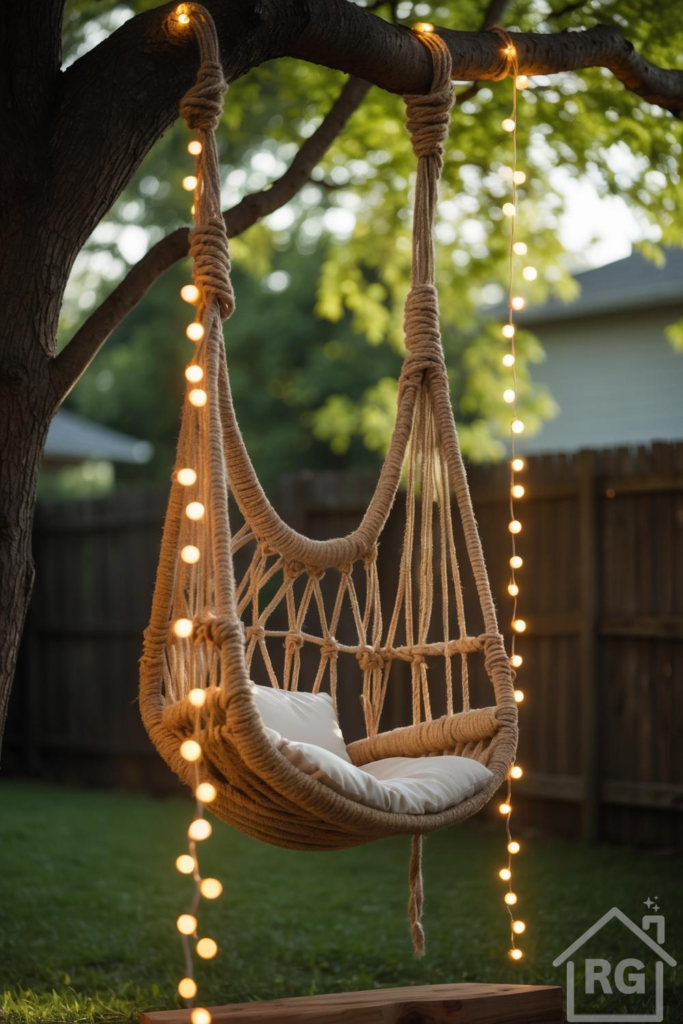
Transforming your backyard into a personal haven doesn’t require a massive overhaul or an exorbitant budget. Sometimes, the simplest additions, like a charming rope swing and a string of twinkling lights, can create an enchanting retreat right outside your door. This guide will walk you through the steps to replicate the serene and inviting atmosphere seen in the image, focusing on practical advice, material choices, and design tips to help you craft your own perfect outdoor escape.
The Allure of the Backyard Retreat
Imagine unwinding after a long day, gently swaying in a comfortable swing, bathed in the soft glow of warm lights. This vision of tranquility is more attainable than you might think. The key lies in blending comfort, natural elements, and thoughtful illumination to create a space that invites relaxation and connection. Whether you have a sprawling lawn or a compact patio, the principles remain the same: identify your focal points, enhance them with appropriate lighting and seating, and surround them with lush greenery.
Choosing and Installing Your Perfect Rope Swing
Selecting the Right Swing
The macrame rope swing chair featured in the image is a popular choice for its bohemian charm and comfort. When selecting a swing, consider:
- Style: Macrame, woven rattan, wooden slat, or even a simple tire swing can each offer a distinct aesthetic. Choose one that complements your existing outdoor decor or sets a new tone.
- Material: For outdoor use, look for weather-resistant materials. Synthetic ropes (like polypropylene or polyester) are durable and resist rot and mildew better than natural fibers like cotton or jute, though natural fibers offer a more rustic look. Cushions should be made from outdoor-grade fabric that resists fading and moisture.
- Comfort: Ensure the swing is comfortable for extended periods. A deep seat and supportive back are crucial. Adding extra cushions and throw pillows can significantly enhance the comfort level.
Safety First: Tree Selection and Installation
The tree is the anchor of your swing, so its health and strength are paramount. Before installing, consult an arborist if you have any doubts about your tree’s suitability.
- Branch Strength: Choose a sturdy, horizontal branch that is at least 8 inches in diameter for a single swing. It should be free of disease, cracks, or dead spots. The branch should be high enough to allow the swing to hang freely without hitting the ground or other obstacles.
- Tree Health: Ensure the tree itself is healthy and mature. Avoid young trees or those showing signs of stress.
- Installation Hardware: Use heavy-duty, outdoor-rated hardware. Tree straps are highly recommended over chains or ropes directly wrapped around the branch, as they prevent girdling and damage to the tree bark. Look for straps designed for tree swings, often made from strong nylon or polyester with D-rings or carabiners.
- Professional Help: If the branch is very high, difficult to access, or you’re unsure about the installation process, consider hiring a professional arborist or a handyman experienced in swing installation. Safety should always be your top priority.
Once installed, regularly inspect the swing, ropes, and tree branch for any signs of wear, damage, or instability. This ensures continued safety and enjoyment.
Illuminating Your Evening Ambiance: Outdoor Lighting
The warm glow of string lights is central to creating that magical, inviting atmosphere. They transform an ordinary backyard into an enchanting evening retreat.
Choosing Your Lights
- Type of String Lights: The image features globe string lights, which emit a soft, diffused light. Other popular options include Edison bulb string lights for a vintage feel, fairy lights for a delicate sparkle, or solar-powered lanterns for scattered light.
- Power Source:
- Electric: Offer consistent brightness and are great for permanent installations. Ensure they are outdoor-rated (UL listed for wet locations) and use a GFCI outlet for safety.
- Solar: Environmentally friendly and easy to install as they don’t require an outlet. Ideal for areas without easy access to power, though their brightness may vary depending on sun exposure.
- Battery-operated: Best for temporary setups or areas where power is impossible. Check battery life and consider rechargeable options.
- Color Temperature: Warm white lights (around 2700K-3000K) create a cozy, inviting ambiance, similar to the image. Cooler white lights (above 4000K) are brighter and more modern.
Creative Placement Strategies
How you drape and arrange your lights significantly impacts the mood:
- Tree Wrapping: Wrap string lights around the tree trunk and main branches, extending them to the swing’s hanging points. This creates a beautiful, integrated look.
- Canopy Effect: If you have multiple trees or poles, string lights overhead to create a “ceiling” of light, defining the sitting area.
- Around the Swing: Gently drape some strands directly around the swing’s frame or hanging ropes, as seen in the image, to highlight it as the focal point.
- Pathways and Borders: Extend lights along pathways or fence lines to guide movement and add depth to your yard.
- Dimmers: Consider adding a dimmer switch for electric string lights. This allows you to adjust the brightness to suit the mood, from bright for gatherings to soft for quiet evenings.
The Foundation: Lawn and Ground Cover
A well-maintained lawn provides a lush, natural carpet for your outdoor space. The vibrant green grass in the image contributes significantly to the fresh and inviting feel.
Lawn Care Essentials
- Mowing: Regular mowing at the correct height encourages dense, healthy growth.
- Watering: Deep, infrequent watering promotes strong root systems. Consider a sprinkler system or smart irrigation for efficiency.
- Fertilizing: Feed your lawn with appropriate fertilizers based on soil tests to ensure it receives necessary nutrients.
- Weed Control: Address weeds promptly to prevent them from competing with your grass.
Alternative Ground Covers
If a full lawn isn’t feasible or desired, consider other options:
- Mulch: Wood chips or bark mulch can create a soft, natural ground cover around the swing area, suppressing weeds and retaining moisture.
- Gravel: Pea gravel or crushed stone can define a seating area, offering a low-maintenance, permeable surface.
- Stepping Stones: Create a path to your swing with natural stone or concrete pavers, adding a structured element to the design.
Defining Your Space: Fencing and Greenery
The wooden privacy fence in the background provides a sense of enclosure and privacy, making the space feel more intimate. It also serves as a backdrop for other design elements.
Wooden Fences
- Privacy and Security: A solid wooden fence offers excellent privacy and can enhance security.
- Aesthetic Appeal: The natural warmth of wood complements green foliage and adds a rustic touch. Regular staining or painting can protect the wood and refresh its appearance.
- Vertical Gardening: Use the fence as a canvas for climbing plants like clematis, jasmine, or climbing roses, or attach vertical planters for herbs or flowers.
Living Fences and Hedges
For a softer, more natural boundary, consider planting a hedge:
- Shrubs: Dense shrubs like privet, boxwood, or arborvitae can create a beautiful, living privacy screen that also provides habitat for local wildlife.
- Bamboo: Clumping bamboo varieties can grow quickly to form a tall, dense screen, but ensure you choose non-invasive types.
Bringing Life: Plants and Planters
Lush greenery is essential for creating a vibrant and natural outdoor setting. The image shows a healthy lawn and mature tree, but you can enhance this with additional plants.
Selecting Suitable Plants
Consider your local climate, sun exposure, and maintenance preferences:
- For Sunny Spots: Petunias, marigolds, coneflowers, lavender, or ornamental grasses thrive in full sun and add bursts of color and texture.
- For Shady Areas: Ferns, hostas, impatiens, or bleeding hearts can bring lushness to dimmer corners.
- Low-Maintenance Options: Succulents, sedum, or certain ornamental grasses require less frequent watering and care, ideal for busy individuals.
- Native Plants: Incorporating native plants supports local ecosystems, often requires less water, and is well-adapted to your climate.
Strategic Placement of Planters
Potted plants offer flexibility and allow you to introduce greenery where direct planting isn’t possible, such as on a patio or balcony, or to add pops of color near your swing.
- Around the Swing: Place large potted ferns or flowering plants near the base of the tree or around the swing to frame the area and add a sense of enclosure.
- Varying Heights: Use planters of different sizes and heights to create visual interest. Tall planters with upright plants can add verticality, while low, wide planters can hold sprawling groundcovers or annuals.
- Herbs and Edibles: Consider planting fragrant herbs like rosemary, mint, or basil in pots near your seating area for both beauty and utility.
DIY Touches and Personalization
Adding personal touches makes your outdoor retreat truly yours.
- Repurposed Decor: Look for old wooden crates, vintage lanterns, or even old tires that can be cleaned up and repurposed as planters or decorative elements.
- Handmade Accents: Craft your own wind chimes, paint garden stones, or create simple outdoor art to hang on the fence.
- Comfort Elements: Beyond the swing cushion, add an outdoor throw blanket for cooler evenings, or a small side table for drinks and books.
- Sound and Scent: Incorporate elements that engage other senses. A small water feature can provide soothing sounds, while fragrant plants like jasmine or gardenias can fill the air with delightful scents.
Maintaining Your Outdoor Sanctuary
Regular maintenance ensures your backyard retreat remains beautiful and functional for years to come.
- Swing and Cushion Care: Clean your swing regularly according to its material. Store cushions indoors during inclement weather or off-season to prolong their life and prevent mildew.
- Light Maintenance: Check string lights periodically for burnt-out bulbs or damaged wires. Clean bulbs gently to maintain their brightness.
- Tree Health: Continue to monitor the tree supporting your swing for any signs of stress or disease. Regular pruning by an arborist can help maintain its health and structure.
- Lawn and Plant Care: Stick to a consistent watering, mowing, and feeding schedule for your lawn and plants. Address pests or diseases promptly.
- Winterization: In colder climates, prepare your outdoor space for winter by storing delicate items, covering furniture, and ensuring plants are protected.
By thoughtfully combining a comfortable swing, ambient lighting, lush greenery, and personal touches, you can create a captivating and relaxing outdoor space that becomes your favorite spot to unwind. It’s about crafting an experience, a place where you can escape the everyday and reconnect with nature, even if it’s just steps from your back door. Enjoy the process of bringing your vision to life and savor every moment in your newly transformed backyard.
